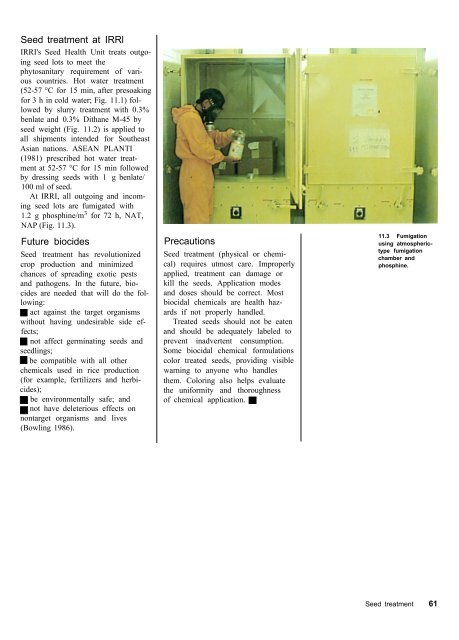A manual of rice seed health testing - IRRI books - International Rice ...
A manual of rice seed health testing - IRRI books - International Rice ...
A manual of rice seed health testing - IRRI books - International Rice ...
- No tags were found...
You also want an ePaper? Increase the reach of your titles
YUMPU automatically turns print PDFs into web optimized ePapers that Google loves.
Seed treatment at IRRl<br />
<strong>IRRI</strong>'s Seed Health Unit treats outgoing<br />
<strong>seed</strong> lots to meet the<br />
phytosanitary requirement <strong>of</strong> various<br />
countries. Hot water treatment<br />
(52-57 °C for 15 min, after presoaking<br />
for 3 h in cold water; Fig. 11.1) followed<br />
by slurry treatment with 0.3%<br />
benlate and 0.3% Dithane M-45 by<br />
<strong>seed</strong> weight (Fig. 11.2) is applied to<br />
all shipments intended for Southeast<br />
Asian nations. ASEAN PLANTI<br />
(1981) prescribed hot water treatment<br />
at 52-57 °C for 15 min followed<br />
by dressing <strong>seed</strong>s with 1 g benlate/<br />
100 ml <strong>of</strong> <strong>seed</strong>.<br />
At <strong>IRRI</strong>, all outgoing and incoming<br />
<strong>seed</strong> lots are fumigated with<br />
1.2 g phosphine/m 3 for 72 h, NAT,<br />
NAP (Fig. 11.3).<br />
Future biocides<br />
Seed treatment has revolutionized<br />
crop production and minimized<br />
chances <strong>of</strong> spreading exotic pests<br />
and pathogens. In the future, biocides<br />
are needed that will do the following:<br />
act against the target organisms<br />
without having undesirable side effects;<br />
not affect germinating <strong>seed</strong>s and<br />
<strong>seed</strong>lings;<br />
be compatible with all other<br />
chemicals used in <strong>rice</strong> production<br />
(for example, fertilizers and herbicides);<br />
be environmentally safe; and<br />
not have deleterious effects on<br />
nontarget organisms and lives<br />
(Bowling 1986).<br />
Precautions<br />
Seed treatment (physical or chemical)<br />
requires utmost care. Improperly<br />
applied, treatment can damage or<br />
kill the <strong>seed</strong>s. Application modes<br />
and doses should be correct. Most<br />
biocidal chemicals are <strong>health</strong> hazards<br />
if not properly handled.<br />
Treated <strong>seed</strong>s should not be eaten<br />
and should be adequately labeled to<br />
prevent inadvertent consumption.<br />
Some biocidal chemical formulations<br />
color treated <strong>seed</strong>s, providing visible<br />
warning to anyone who handles<br />
them. Coloring also helps evaluate<br />
the uniformity and thoroughness<br />
<strong>of</strong> chemical application.<br />
11.3 Fumigation<br />
using atmospherictype<br />
fumigation<br />
chamber and<br />
phosphine.<br />
Seed treatment 61

















